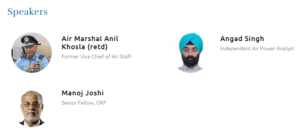Q-1 Has Indian foreign policy become more assertive about India’s interests?
A-1
- The trend for foreign policy is changing worldwide.
- Multilateralism is changing to mini-lateralism.
- The engagements between countries have become interest and issue-based.
- India’s policy has changed from a policy of non-alignment to a policy of equidistance.
- The engagements are governed by own interests, needs, and gains.
- The world is accepting Indian stand on various issues.
- Indian assertion level is appropriate, generally in take it or leave it mode without thrusting it upon others.
Q-2 Comments about India’s focus on Asian region and neighborhood.
A-2
- Focus on Asia and the neighborhood has come a bit late with China having made inroads into our neighborhood adopting the string of pearls policy.
- We need to be magnanimous in our approach towards our neighbours to retain them with us.
- Like any other country, our global engagements are based on our interests first and then on ideology and principles.
Q-3. Comments on India’s moral-based foreign policy, with a principled approach, and not using its military power for foreign policy objectives.
A-3
- In agreement with the statement that “India foundationally remains a pacifist state, following moral based foreign policy, the strength of soft power and principled approach”.
- It is not necessary to use force and military might to attain one’s foreign policy objectives.
- Hard power can be used as a soft power as well using Military Diplomacy to achieve one’s objectives.
- Foreign policy and military diplomacy need to work cohesively.
- Notwithstanding the above, India has in the past used its hard power to attain its foreign policy objectives. Examples include Bangladesh liberation, Sri Lanka and Maldives operations.
Q-4. India needs to spend more on its conventional military forces, building military capabilities and deterrence, due to its regional and global aspirations.
A-4
- At the moment India’s necessity to invest in building conventional military power is governed more by its threat perception and need to guard its interests.
- Regional and or global aspirations come next.
- Military capability and deterrence are essential to be considered as a major regional power.
- Military power alone is not sufficient, it has to be backed by economic clout and strength.
Q-5 In an age of comprehensive security, is military power by itself adequate?
A-5
- While it is true that, military power is a significant ingredient of power projection it greatly impacts international dynamics and relations between nations.
- It alone cannot achieve national objectives. It has to be backed by economic clout and a balanced all-round deterrence capability.
- Earlier the debate used to be between money being spent on development or military capability.
- Military power is essential even for unhindered growth.
- The nature of warfare is changing. Firstly, hostile actions do take place even in no-war scenarios and secondly, the hostilities are not limited to the military alone.
- New dimensions of warfare have emerged that affect the entire nation and demand a whole of national response.
- The question of choice is not as simple as “either one or the other”. A balanced approach is required for multi-dimensional holistic capability enhancement.
- Balance has to be maintained between:-
- Military power and other tools of statecraft.
- Conventional military power and other dimensions of warfare.
- Military capability and capacity to wage war.
- Quality and quantity of platform, weapons, and war-waging wherewithal.
- Military capability and adequate deterrence are required first and foremost for safeguarding own interests, thereafter comes regional/global responsibilities and aspirations.
Q-6 India with its present stage of development, can ill afford to suffer a military setback, due to loss of deterrence as a result of inadequate defence funding.
A-6
- In agreement with the statement.
- The minimum credible deterrence value of the military needs to be maintained at all times.
- The minimum deterrence value depends upon, the number of enemies, their military capabilities, and their attitude.
- In India’s case, the enemy’s capabilities are racing ahead creating a wide gap and the attitude has become more belligerent and aggressive.
Q-7. What does a ‘credible military capability’ entail?
A-7
Credible military capability to my mind would entail the following in sequence:-
- Adequate deterrence.
- The ability for strategic coercion.
- Punitive capability.
- Ability to wage war if required,
- Adequate war endurance.
- Ability to provide human assistance and disaster relief (HADR) domestically as well as externally.
- Capability to exploit Defence Diplomacy.
Collective security is valid not only during the war but also to deal with grey zone operations during the time of peace.
Q-8. What capabilities are required for military hard power to become an effective means of state-craft?
A-8
The military alone cannot achieve the national objectives. Besides aspects mentioned earlier areas which need attention are:-
- Ability to meet challenges in the nonconventional and new domains of warfare including Nuclear, Biological, Space, Cyber, Electronic, and Information.
- Any reorganization should be to cater for future challenges in these domains.
- A robust defence industry and production eco-system are essential.
- Intangible factors like morale and training are very important along with doctrine, strategy, and tactics.
- Reach, precision, standoff, and a robust supply chain are equally important.
Suggestions and value additions are most welcome
For regular updates, please register here
References and credits
To all the online sites and channels.
Disclaimer:
Information and data included in the blog are for educational & non-commercial purposes only and have been carefully adapted, excerpted, or edited from sources deemed reliable and accurate. All copyrighted material belongs to respective owners and is provided only for purposes of wider dissemination.


